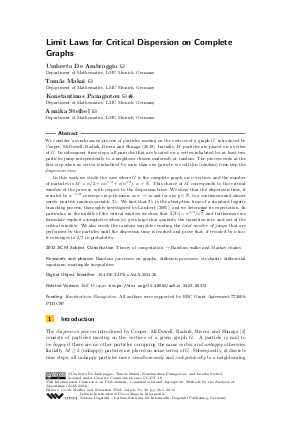Limit Laws for Critical Dispersion on Complete Graphs
Authors Umberto De Ambroggio, Tamás Makai, Konstantinos Panagiotou, Annika Steibel
-
Part of:
Volume:
35th International Conference on Probabilistic, Combinatorial and Asymptotic Methods for the Analysis of Algorithms (AofA 2024)
Part of: Series: Leibniz International Proceedings in Informatics (LIPIcs)
Part of: Conference: International Conference on Probabilistic, Combinatorial and Asymptotic Methods for the Analysis of Algorithms (AofA) - License:
 Creative Commons Attribution 4.0 International license
Creative Commons Attribution 4.0 International license
- Publication Date: 2024-07-18
File

PDF
LIPIcs.AofA.2024.26.pdf
- Filesize: 0.67 MB
- 12 pages
Document Identifiers
Related Versions
- Full Version https://doi.org/10.48550/arXiv.2403.05372
Subject Classification
ACM Subject Classification
- Theory of computation → Random walks and Markov chains
Keywords
- Random processes on graphs
- diffusion processes
- stochastic differential equations
- martingale inequalities
Metrics
- Access Statistics
-
Total Accesses (updated on a weekly basis)
0PDF Downloads0Metadata Views
Abstract
We consider a synchronous process of particles moving on the vertices of a graph G, introduced by Cooper, McDowell, Radzik, Rivera and Shiraga (2018). Initially, M particles are placed on a vertex of G. In subsequent time steps, all particles that are located on a vertex inhabited by at least two particles jump independently to a neighbour chosen uniformly at random. The process ends at the first step when no vertex is inhabited by more than one particle; we call this (random) time step the dispersion time.
In this work we study the case where G is the complete graph on n vertices and the number of particles is M = n/2+α n^{1/2} + o(n^{1/2}), α ∈ ℝ. This choice of M corresponds to the critical window of the process, with respect to the dispersion time. We show that the dispersion time, if rescaled by n^{-1/2}, converges in p-th mean, as n → ∞ and for any p ∈ ℝ, to a continuous and almost surely positive random variable T_α. We find that T_α is the absorption time of a standard logistic branching process, thoroughly investigated by Lambert (2005), and we determine its expectation. In particular, in the middle of the critical window we show that 𝔼[T₀] = π^{3/2}/√7, and furthermore we formulate explicit asymptotics when |α| gets large that quantify the transition into and out of the critical window. We also study the random variable counting the total number of jumps that are performed by the particles until the dispersion time is reached and prove that, if rescaled by nln(n), it converges to 2/7 in probability.
Cite As Get BibTex
Umberto De Ambroggio, Tamás Makai, Konstantinos Panagiotou, and Annika Steibel. Limit Laws for Critical Dispersion on Complete Graphs. In 35th International Conference on Probabilistic, Combinatorial and Asymptotic Methods for the Analysis of Algorithms (AofA 2024). Leibniz International Proceedings in Informatics (LIPIcs), Volume 302, pp. 26:1-26:12, Schloss Dagstuhl – Leibniz-Zentrum für Informatik (2024)
https://doi.org/10.4230/LIPIcs.AofA.2024.26
BibTex
@InProceedings{deambroggio_et_al:LIPIcs.AofA.2024.26,
author = {De Ambroggio, Umberto and Makai, Tam\'{a}s and Panagiotou, Konstantinos and Steibel, Annika},
title = {{Limit Laws for Critical Dispersion on Complete Graphs}},
booktitle = {35th International Conference on Probabilistic, Combinatorial and Asymptotic Methods for the Analysis of Algorithms (AofA 2024)},
pages = {26:1--26:12},
series = {Leibniz International Proceedings in Informatics (LIPIcs)},
ISBN = {978-3-95977-329-4},
ISSN = {1868-8969},
year = {2024},
volume = {302},
editor = {Mailler, C\'{e}cile and Wild, Sebastian},
publisher = {Schloss Dagstuhl -- Leibniz-Zentrum f{\"u}r Informatik},
address = {Dagstuhl, Germany},
URL = {https://drops.dagstuhl.de/entities/document/10.4230/LIPIcs.AofA.2024.26},
URN = {urn:nbn:de:0030-drops-204617},
doi = {10.4230/LIPIcs.AofA.2024.26},
annote = {Keywords: Random processes on graphs, diffusion processes, stochastic differential equations, martingale inequalities}
}
Author Details
Funding
- Panagiotou, Konstantinos: All authors were supported by ERC Grant Agreement 772606-PTRCSP.
References
-
K. Bringmann, F. Kuhn, K. Panagiotou, U. Peter, and H. Thomas. Internal DLA: Efficient simulation of a physical growth model. In Automata, Languages, and Programming, pages 247-258, Berlin, Heidelberg, 2014. Springer Berlin Heidelberg.

- C. Cooper, A. McDowell, T. Radzik, N. Rivera, and T. Shiraga. Dispersion processes. Random Structures Algorithms, 53(4):561-585, 2018. URL: https://doi.org/10.1002/rsa.20822.
- U. De Ambroggio, T. Makai, and K. Panagiotou. Dispersion on the complete graph, 2023. An extended abstract appeared in the Proceedings of EUROCOMB '23. URL: https://arxiv.org/abs/2306.02474.
-
P. Diaconis and W. Fulton. A growth model, a game, an algebra, Lagrange inversion, and characteristic classes. Rend. Sem. Mat. Univ. Politec. Torino, 49(1):95-119, 1991.

-
R. Durrett. Stochastic calculus - a practical introduction. Probability and Stochastics Series. CRC Press, Boca Raton, FL, 1996.

- A. Frieze and W. Pegden. A note on dispersing particles on a line. Random Structures Algorithms, 53(4):586-591, 2018. URL: https://doi.org/10.1002/rsa.20821.
- A. Lambert. The branching process with logistic growth. Ann. Appl. Probab., 15(2):1506-1535, 2005. URL: https://doi.org/10.1214/105051605000000098.
-
G. F. Lawler, M. Bramson, and D. Griffeath. Internal diffusion limited aggregation. Ann. Probab., 20(4):2117-2140, 1992.

- L. T. Rolla. Activated Random Walks on ℤ^d. Probability Surveys, 17:478-544, 2020. URL: https://doi.org/10.1214/19-PS339.
- Y. Shang. Longest distance of a non-uniform dispersion process on the infinite line. Inform. Process. Lett., 164:106008, 5, 2020. URL: https://doi.org/10.1016/j.ipl.2020.106008.
